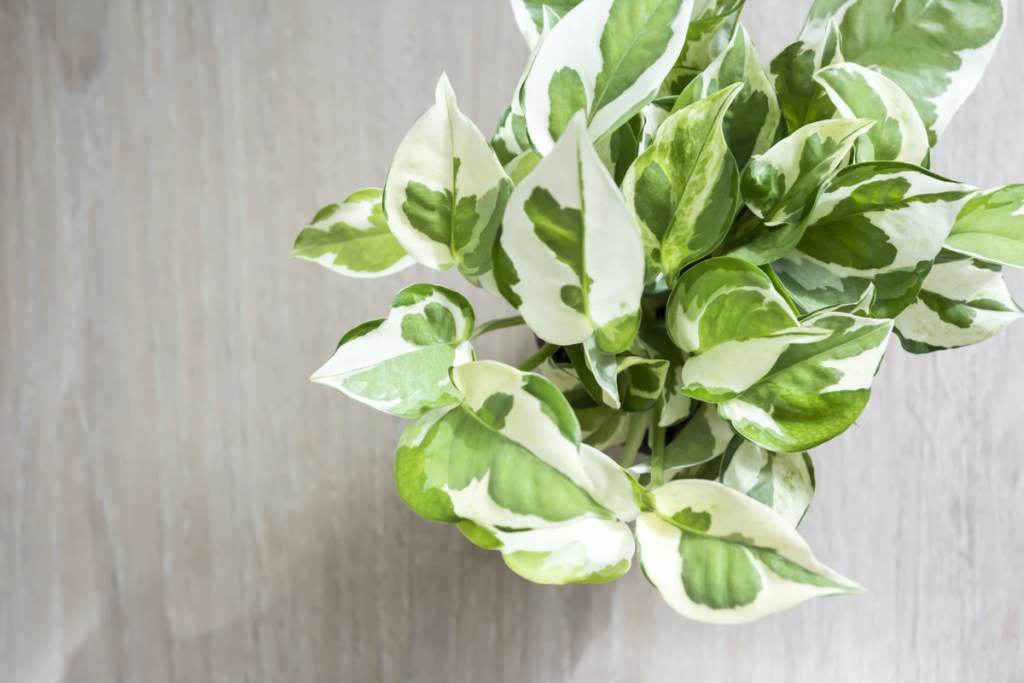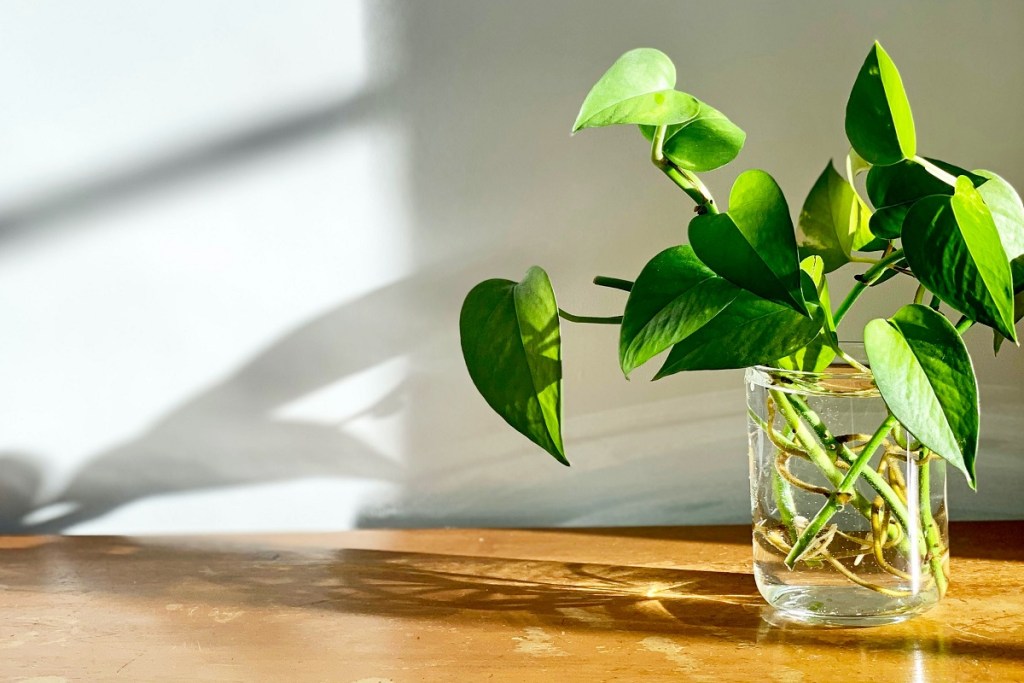Pothos plants are widely known as one of the best plants for beginner indoor gardeners and can be a great way to show creativity. They can be used as accent vines on walls that get a lot of light or have their leaves cascade down from the top of a shelf. Pothos plants are great for a wide variety of environments; however, just because they’re hardy doesn’t mean they’re invincible. Pothos experience their fair share of issues when not cared for properly, and it may take a process of trial and error to figure out what’s going on.
Common problems that affect pothos plants
Pothos varieties are susceptible to quite a few problems, but they’re all fairly easy to solve.
From yellowing leaves to disappearing variegation, none of them are a death sentence (when caught early enough) so long as you know how to manage the problem.
Keep in mind, though, that some of these problems aren’t always an issue and happen naturally over the course of the plant’s life. As new leaves start growing, older ones near the base of the plant will start to yellow and die. This is because your pothos is focusing its energy on growing bigger and stronger. In this case, you have nothing to worry about! But if a lot of leaves start to yellow, it may be a sign of a bigger problem.

Yellowing leaves
Yellowing leaves are most commonly caused by improper moisture and watering. Overwatering is usually the culprit, as pothos plants don’t like to have wet feet or sit in soggy soil. You should only water when the top quarter of the soil or so is dry, and do your best to make sure it’s evenly damp after watering.
Improper and inconsistent watering create unnecessary stress, which is what causes the yellowing leaves. In the winter especially, pothos plants don’t need as much water due to winter dormancy. So if you start seeing yellow leaves during colder months, you’re likely watering your plant too often.
How to solve the problem: With yellowing leaves, the unfortunate thing is that you’ll want to trim off any foliage that’s too far gone as that will allow the pothos to direct energy toward healthy and new growth. From there, make sure that you’re only watering until some starts seeping out the drainage hole, then wait to water again until the top layer of soil is dry. If your pothos is particularly soggy, you may want to consider repotting in fresh, dry soil.
Black spots
Like yellowing leaves, black spots can also be a sign of overwatering to the point of root rot, though they can also be caused by low temperatures. A sudden onset of black spots that appear to be isolated on a certain part of the plant is most likely an indicator that it’s not warm enough; however, gradually appearing black spots that spread around the entire plant are a sign that something’s wrong with the roots.
In case of the latter, you should remove the plant from the pot and check to see if the roots are black, smelly, or soft. If so, you’ve got a larger issue to solve.
How to solve the problem: A pothos near a draft can simply be moved to a warmer location. If you have root rot, though, you should start by rinsing the soil gently off the roots and trimming any areas that are rotting, then you can repot in fresh soil in a pot with good drainage.
Drooping leaves
Opposite yellowing leaves and black spots, drooping leaves are most often caused by low humidity levels and under-watering. They usually start to happen when the soil is too dry, especially when it dries out completely. At this stage, the drooping is usually accompanied by limp vines and browning.
How to solve the problem: Give your pothos a good drink if the soil is dry. If it’s dry all the way through, you’ll want to thoroughly soak it. Simply place your plant in a sink, fill the sink with three to four inches of water, let the pothos soak for 45 minutes, then drain the sink.
If the soil isn’t dry, the culprit is likely low humidity levels. If that’s the case, you can increase the humidity around your pothos by regularly misting the leaves, using a space humidifier, or placing the plant on a small tray of pebbles filled with water. Another option is to put it in a spot around other plants, which will naturally create higher humidity.
Browning
Browning leaves have a few different causes: over-watering, under-watering, and too much direct sunlight. The problem you face will depend on the type of brown spots that appear on your plant.
If you’re overwatering your pothos, the brown spots will usually be darker and softer. For under-watering, they tend to be light and crisp. In both cases, you should check the soil to confirm if you think one of these is the problem you’re facing. In the case of direct sunlight, the brown spots will be accompanied by a scorched appearance on the leaves (sunburn).
How to solve the problem: Once you figure out which problem you’re facing, the solution is simple. If you’ve been overwatering your pothos, the best course of action is to repot it in fresh, dry soil. For under-watering, give it a nice drink of water and be sure to maintain consistent waterings. If your pothos has been sunburned, you should move it to a location with lots of indirect sunlight as opposed to direct. In every scenario, you should trim off any dead or damaged foliage to allow your pothos to use its energy on new and healthy leaves.

Pests
Pests often accompany one of the above issues, as a pothos that’s stressed or weakened is more susceptible to infestation. Sap-suckers like spider mites will drain the moisture from your plant, often resulting in yellow leaves and fronds. Scale and mealybugs are also common for many houseplants. If they aren’t caught and taken care of early on, there’s a risk that they’ll nestle into nooks in your plant, as well as spread to the rest of your collection.
How to solve the problem: If you notice bugs on your pothos, you should immediately quarantine it away from the rest of your indoor plants to prevent further spread. To get rid of the pests, you should use an insecticidal soap that’s safe for houseplants. Not all of them are the same, so be sure to follow the directions carefully in order to give your pothos the best chance of survival. Be sure to inspect your other houseplants to see if they have any signs of infestation.
Little to no variegation (if it’s a variegated variety)
In variegated pothos varieties, disappearing variegation can be concerning; however, it’s probably the least-concerning issue pothos plants can face! Variegated varieties, like the margle queen, produce less chlorophyll (which is what results in the beautiful variegation). This means that they require more light than full green-leafed varieties to be able to have the energy they need to survive. If you notice new growth is missing its variegation, you’ve likely got your pothos in an environment where it isn’t receiving enough light and has started producing more chlorophyll to photosynthesize properly.
How to solve the problem: The solution for this one is luckily quite simple. Move your pothos to a new location where it will get lots of indirect sunlight, and you should see the variegation start to come back on new leaves! Be careful not to choose a spot that receives a lot of direct sunlight, though, as the plant can easily burn.
What you can do to help prevent future issues
The best thing you can do to keep your pothos healthy, happy, and free of future issues is to provide proper care and maintenance. A lot of the issues pothos plants face can be solved and prevented by maintaining their preferred water schedule and making sure they receive a good amount of indirect lighting.
Proper care helps keep pests away, and it minimizes the amount of things that could be wrong if you start to notice issues. For example, if you have brown spots on the leaves but you’ve been watering properly, chances are there’s too much sun exposure. Although they’re hardy plants, a neglected pothos will never be a happy pothos. For healthy growth and results, give your pothos (and all your houseplants!) the best care you possibly can.
Editors' Recommendations
- Stunning Monstera plants that you should add to your indoor plant collection
- Beyond basil and cilantro, add these unique plants to your indoor herb garden
- 5 easy-care spider plant varieties perfect for any home garden
- Easy hoya plants to add to your indoor plant collection
- Do ZZ plants cause cancer? Here’s the definitive answer



